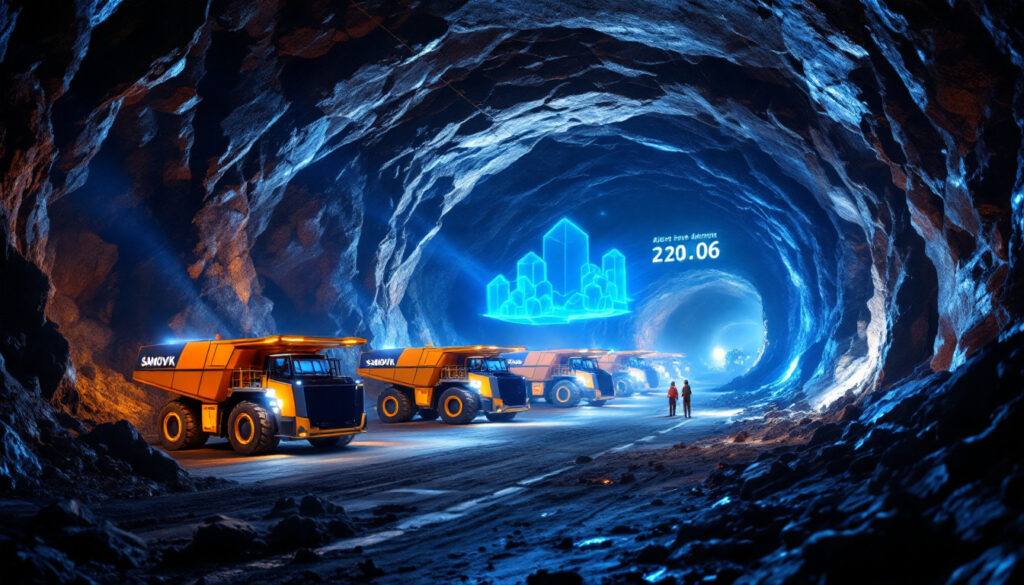Sandvik Wins Record Order for Battery-Electric Mining Equipment
South32 has awarded Sandvik Mining and Rock Solutions a groundbreaking contract for battery-electric vehicles (BEVs), marking the largest-ever BEV order in Sandvik's history. This landmark agreement will supply South32's greenfield Hermosa project in Arizona with a comprehensive fleet of zero-emission underground mining equipment, positioning both companies at the forefront of sustainable mining operations.
The Hermosa project represents a strategic investment in the US critical minerals supply chain, with South32 developing what could become one of North America's most significant sources of zinc, lead, silver, and manganese. These resources are classified as critical minerals by the US government, essential for renewable energy technologies, electric vehicles, and national security applications.
"We're proud that Sandvik's battery-electric vehicles will play a crucial role in developing this strategically important project," stated Stefan Widing, Sandvik's President and CEO. "This record order demonstrates the mining industry's accelerating shift toward sustainable technologies and South32's commitment to environmentally responsible resource extraction."
The Landmark Deal with South32
The agreement between Sandvik and South32 marks a watershed moment in mining equipment procurement. While the exact financial terms remain undisclosed, industry analysts estimate the deal's value in the tens of millions of dollars, encompassing multiple equipment types across Sandvik's BEV portfolio.
South32, a globally diversified mining and metals company, has emphasized its commitment to sustainability across its operations. The Hermosa project represents one of the company's flagship investments in next-generation mining technology, with the BEV fleet eliminating diesel emissions from underground operations entirely.
"This partnership with Sandvik aligns perfectly with our decarbonization roadmap," explained Graham Kerr, South32's Chief Executive Officer. "By deploying an all-electric fleet at Hermosa from day one, we're demonstrating our commitment to responsible development while also realizing significant operational advantages."
Significance of the Hermosa Project
The Hermosa project is located approximately 80 kilometers southeast of Tucson in Arizona's Santa Cruz County. Classified as a Tier 1 asset, the project encompasses two distinct deposits: Taylor (zinc-lead-silver) and Clark (manganese). The Taylor deposit alone contains an estimated 138 million tonnes of mineral resources, positioning it among the largest undeveloped zinc resources globally.
Beyond its commercial value, Hermosa holds strategic importance for US materials security. The Biden administration's critical minerals strategy has identified domestic production as essential for reducing dependence on foreign suppliers, particularly for battery materials like manganese. The project's development timeline coincides with unprecedented federal investment in domestic supply chains through initiatives like the Inflation Reduction Act and the Infrastructure Investment and Jobs Act.
"Hermosa represents the future of critical mineral development in the United States," noted Drew Berg, mining analyst at Global Resource Partners. "The deployment of battery-electric equipment demonstrates how modern mining can align environmental performance with resource security priorities."
Battery-Electric Vehicle Specifications
Sandvik's equipment package for Hermosa includes an array of purpose-built underground mining machines, featuring the company's latest BEV technology. The order encompasses a comprehensive fleet including:
- Sandvik LH518B loaders with 18-tonne capacity
- Sandvik TH550B trucks designed for high-productivity haulage
- Sandvik DD422iE electric development drill rigs
- Sandvik DS412iE electric bolters
- Supporting utility vehicles and infrastructure
Each machine features Sandvik's fourth-generation battery systems, which incorporate liquid cooling technology, rapid charging capability, and energy recuperation systems. The high-capacity lithium-ion battery packs deliver power densities comparable to diesel engines while eliminating exhaust emissions entirely.
"Our battery systems are designed specifically for underground mining conditions," explained Henrik Ager, President of Sandvik Mining and Rock Solutions. "The modular architecture allows for battery swapping in under ten minutes, minimizing downtime while providing consistent performance throughout shifts."
Environmental and Operational Benefits
The transition to battery-electric vehicles delivers multiple advantages beyond simply eliminating diesel emissions. In underground environments, the absence of exhaust gases can reduce ventilation requirements by up to 50% compared to diesel-powered operations, generating significant energy savings and reducing infrastructure costs.
BEVs also produce substantially less heat than diesel equipment – typically 30-40% less thermal output – which further reduces cooling demands in deep mining operations. This becomes increasingly important as mines extend to greater depths where ambient temperatures rise naturally with geothermal gradients.
Sound levels represent another significant improvement, with Sandvik's BEVs operating at 65-70 decibels compared to 85-95 decibels for conventional diesel equipment. This noise reduction improves communication safety underground while reducing operator fatigue and potential hearing damage.
"The working environment improvements can't be overstated," noted Jason Kramer, mining operations specialist at Technical Mining Consultants. "Lower noise, zero emissions, and reduced heat collectively transform the underground workspace, improving productivity while meeting increasingly strict occupational health standards."
Market Leadership in Mining Electrification
Sandvik's record order reinforces its position as a market leader in mining electrification. The company has invested heavily in BEV technology over the past decade, developing purpose-built electric equipment rather than simply retrofitting existing diesel models.
The global electric mining equipment market is currently valued at approximately $6.5 billion and projected to grow at a CAGR of 12.5% through 2030, according to Allied Market Research. This growth trajectory reflects both environmental pressures and operational advantages driving mining decarbonisation revolution across the industry.
Sandvik now competes in a rapidly evolving market that includes established players like Epiroc, which recently secured a $150 million order for autonomous electric mining equipment from a major mining company. Other competitors include Caterpillar, whose R1700 XE loader represents its entry into the BEV segment, and Komatsu, which has developed its own battery-electric LHD machines.
"What we're seeing is a competitive race to establish leadership in the mining electrification space," explained Maria Thompson, mining technology analyst at Resource Innovation Partners. "Sandvik's order from South32 represents a significant endorsement of their technology approach and positions them strongly in the North American market."
Industry Shift Toward Zero-Emission Mining
The South32 order represents part of a broader industry transition toward decarbonized mining operations. Major mining companies including Rio Tinto, BHP, Anglo American, and Newmont have all announced net-zero commitments, with equipment electrification forming a key component of their emissions reduction strategies.
This shift is accelerating due to multiple factors: regulatory pressures, investor ESG in mining expectations, operational efficiencies, and technological maturity. Underground operations represent the logical starting point for electrification due to the immediate air quality benefits and ventilation cost savings.
"We've reached the tipping point where battery-electric equipment makes both environmental and economic sense," noted Carlos Fernandez, mining innovation director at Global Mining Solutions. "The total cost of ownership now favors electric solutions in many applications, particularly when accounting for ventilation savings, maintenance reductions, and carbon pricing."
The International Council on Mining and Metals (ICMM), representing 28 of the world's largest mining companies, has committed its members to achieving net-zero Scope 1 and 2 emissions by 2050, with equipment electrification playing a central role in this transition.
Recent Significant Equipment Deals
Sandvik wins record order for battery-electric mining equipment following other significant mining equipment contracts that highlight the industry's technological transformation. In early 2024, Epiroc announced a $150 million order for battery-electric and autonomous equipment from a North American mining company, including approximately 30 battery-electric vehicles alongside automation systems.
Similarly, Newmont committed to a mixed fleet of electric vehicles for its Borden mine in Ontario, Canada – the first all-electric underground gold mine in the country. The project demonstrated that all-electric operations could achieve both environmental and productivity targets.
In Australia, BHP has deployed electric vehicles at its Olympic Dam operation, while Evolution Mining has implemented battery-electric trucks at its Red Lake complex in Canada. These deployments, while smaller in scale than South32's order, demonstrate the global nature of the electrification trend.
"What distinguishes the South32 order is its comprehensive approach," explained Michael Anderson, mining industry consultant. "Rather than starting with a few pieces of equipment, they're committing to a full electric fleet from day one, which requires significant infrastructure planning but maximizes the operational benefits."
Competitive Landscape
The competition in battery-electric mining equipment has intensified significantly over the past five years. Sandvik and Epiroc, both Swedish companies with long histories in underground mining equipment, have emerged as early market leaders, each taking slightly different technological approaches.
Sandvik has focused on developing purpose-built electric machines with swappable battery systems, while Epiroc has emphasized equipment automation alongside electrification. Both companies offer comprehensive underground equipment lines, from drilling machines to load-haul-dump (LHD) units and transport vehicles.
Traditional mining equipment manufacturers including Caterpillar and Komatsu have accelerated their electric equipment development programs in response to growing market demand. Caterpillar recently unveiled its R1700 XE battery-electric LHD, while Komatsu has introduced the WX09 battery hauler for narrow-vein mining applications.
"The technology differentiation between suppliers is becoming increasingly important," noted Sarah Williams, equipment analyst at Mining Equipment Digest. "Battery management systems, charging infrastructure, and digital mining innovations are now key competitive factors, beyond simply offering zero-emission alternatives."
Investment Value and Business Impact
While Sandvik has not disclosed the exact financial value of the South32 order, industry analysts estimate it could represent $50-80 million in equipment sales, with additional service agreements potentially extending the contract value further. The deal will materially impact Sandvik's BEV business segment, which the company has identified as a strategic growth area.
For Sandvik, the order validates its technological approach and provides a high-profile reference case for its BEV portfolio. The company's stock rose approximately 3% following the announcement, reflecting investor confidence in its electrification strategy.
"This deal represents more than just equipment sales," explained Henrik Ager, President of Sandvik Mining and Rock Solutions. "It establishes a long-term partnership with South32 and demonstrates the mining industry's readiness to embrace zero-emission technologies at scale."
Long-Term Economic Benefits
The economic case for battery-electric mining equipment continues to strengthen as technology matures and operational experience accumulates. While BEVs typically carry a 25-35% price premium over diesel equivalents, the total cost of ownership (TCO) analysis increasingly favors electric solutions.
Key economic benefits include:
- Reduced ventilation requirements, potentially saving millions annually in electricity costs
- Lower maintenance expenses, with electric powertrains having fewer components and longer service intervals
- Eliminated diesel fuel costs, which typically represent 20-30% of equipment operating expenses
- Extended equipment life due to reduced vibration and component stress
- Potential carbon credit benefits in jurisdictions with emissions trading systems
Studies from mining consultancies indicate that BEVs can achieve 20-30% lower total cost of ownership over a 10-year lifecycle, with the advantage growing as battery costs continue to decline and diesel prices face long-term upward pressure.
FAQs About Battery-Electric Mining Equipment
What are the key advantages of battery-electric mining equipment?
Battery-electric vehicles eliminate diesel emissions underground, dramatically improving air quality and reducing ventilation requirements. Modern mining operations typically allocate 30-40% of their energy consumption to ventilation and cooling systems, making this a significant cost driver.
BEVs also reduce noise levels by 15-25 decibels compared to diesel equipment, improving communication safety and reducing operator fatigue. The machines generate less heat, further reducing cooling demands in deep mines where temperatures naturally increase with depth.
Additionally, electric motors provide full torque from zero RPM, improving performance on inclines and reducing cycle times in load-haul operations. The simplified drivetrain components also reduce maintenance requirements and increase mechanical reliability.
How does the performance of BEVs compare to traditional diesel equipment?
Modern mining BEVs now match or exceed diesel performance in most operating parameters. The latest generation of Sandvik LH518B loaders, for example, delivers equivalent payload capacity (18 tonnes) to comparable diesel models while providing superior acceleration due to the electric motor's torque characteristics.
Operating time between charges has been a historical limitation, but current battery systems typically deliver 4-8 hours of continuous operation depending on duty cycle and can be recharged to 80% capacity in under an hour using fast-charging systems. Many operations implement opportunity charging during shift changes or meal breaks to ensure continuous availability.
Performance advantages become particularly apparent in extreme conditions – high-altitude operations where diesel engines lose power, or deep mines where heat management becomes critical. Electric motors maintain consistent performance regardless of altitude and generate substantially less heat than internal combustion engines.
What infrastructure is needed to support battery-electric mining fleets?
Implementing BEV fleets requires significant charging infrastructure planning. Operations typically need a combination of:
- High-capacity DC fast charging stations (up to 150kW) strategically located near production areas
- Battery swapping stations for equipment with exchangeable battery systems
- Upgraded electrical distribution systems to handle charging loads
- Energy management systems to optimize charging schedules and power demand
- Equipment condition monitoring capabilities and predictive maintenance systems
Electrical infrastructure represents the most significant implementation challenge, particularly for existing mines that must upgrade power distribution systems. Greenfield projects like Hermosa benefit from designing electrical infrastructure specifically for BEV requirements from the outset.
A typical mid-sized underground operation might require 5-7 charging stations with combined capacity of 750kW-1MW, representing a capital investment of $1.5-2.5 million beyond the equipment itself.
What is the expected lifespan of mining BEV batteries?
Battery lifespan in mining applications has improved significantly with current lithium-ion systems typically designed for 5-7 years of operational life or approximately 2,000-3,000 charge cycles. Factors affecting battery longevity include depth of discharge patterns, operating temperatures, and charging protocols.
Modern battery management systems (BMS) optimize charging patterns and cell balancing to extend useful life, while thermal management systems prevent overheating during rapid charging or high-demand operation. Most manufacturers now offer battery warranties of 3-5 years, with performance guarantees ensuring minimum capacity throughout the warranty period.
End-of-life batteries retain 70-80% of their original capacity, making them suitable for second-life applications such as stationary energy storage. Recycling protocols are well-established, with recovery rates exceeding 95% for critical materials like cobalt, nickel, and lithium.
The adoption of digital twins in mining and AI fleet management technologies is further enhancing the operational efficiency of these battery-electric fleets, allowing for predictive maintenance and optimal vehicle utilization throughout their lifecycle.
Want to Spot the Next Major Mining Breakthrough Before the Market?
Discovery Alert's proprietary Discovery IQ model instantly identifies significant mineral discoveries on the ASX, delivering real-time alerts that give investors a crucial market advantage. Explore how historical discoveries have generated exceptional returns by visiting our dedicated discoveries page and start your 30-day free trial today.




